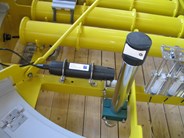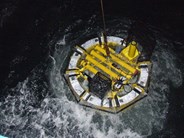Sea-Flume
Sea flume:
Field Measurement of Sediment Erodibility. Benthic flume for max. 400 m depth. It's a device for in situ studies of threshold, erosion velocity and erosional behavior of undisturbed marine muds. An understanding of the erosion potential ('erodibility') of aquatic sediments is important for a wide number of contemporary environmental issues, including benthic habitat stability, contaminated sediment dispersal, river bank and river bed stability, and the geomorphology of estuaries and coastal areas.
The Partrac Voyager Series benthic flumes are field instruments
which measure erodibility in situ (i.e. without the need to collect
sediment and return it to the laboratory). These devices can be
used on marine and fluvial sediments. The instrument isolates a
known volume of water at the sediment-water interface, and a motor
drive circulates the water at sequentially increasing
velocities to produce a series of frictional stresses on the
surface sediments.
A range of sensors measure the flow velocity/turbulence and
induced erosion. The collected data allows rapid assessment of
sediment critical entrainment stress, provides the form of the bed
stress and erosion rate relationship, and can also provide
information on bulk
deposition rate and settling velocity of re-suspended
sediments.
If sedimentological data are available, additional metrics such
as the bed friction angle and shear strength versus depth can be
derived. On-board cameras provide a visual record of erosion as it
occurs (providing bedload transport rates for sands and gravels),
and the instruments can be equipped with a water sampler to collect
samples of the interior water for analysis e.g. grain
size, nutrient analyses. Two types of benthic flume are
available:
Series I flumes are autonomous instruments, designed to be cast off from a vessel to collect erosion/deposition data autonomously. These are battery powered flumes, with onboard data logging and computer based command-control functionality.
Series II flumes are cabled instruments, with power provided to the flume from the surface and a data cable link to provide data in real-time.
Adjustable brackets for various equipment, CCD camera, light, etc.
- Manufactured from 4 mm aluminium, ALMg3 (UK Norm N5)
seawater resistant. - A gear motor (with adjustable speed) is pulling 8 pcs of
paddles
at the inside of the chamber. - The inner side of the chamber wall has a window for the
CCD
camera and lamps. - The outer chamber wall has a horizontal ring to avoid the
subsidence of the sea flume into the sea bed.
The ring has room for lead weights to adjust the balance of
the flume - The flume chamber is closed by a lid, divided in 4
sections,
equipped with seals - Adjustable brackets for sub logger, camera and lamps
- Sediment sampler, based on the Kajak system
- Multi water sampler, released by a burn wire system
- Operational depth: Max. 400 m
- Outer diameter: 200,8 cm
- Inner diameter: 196,2 cm
- Height: 50 cm
- Battery cylinder, 2 pcs, Lithium, capacity 280 Ah
- The Sea Flume has been developed in cooperation with
Kevin Black, Patrac Ltd,141 St James Road, Glasgow, G4 0LT,
UK.
T: + 44 (0) 141 303 8255
F: + 44 (0) 141 552 3886
E: info@partrac.com



 Benthic chamber
Benthic chamber





